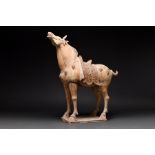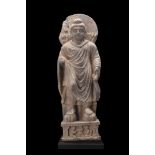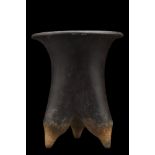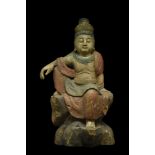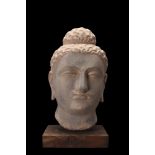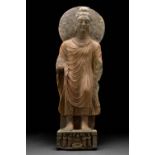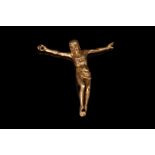Filtered by:
- Category
- List
- Grid
A subscription to the Price Guide is required to view results for auctions ten days or older. Click here for more information
Ca. 618-906 AD. A large horse figure depicted in a standing pose, with its head held high and its ears alert, conveying a sense of energy and vita...
Ca. 100-200 AD. A schist stone carving of a standing Buddha performing Twin Miracles. The figure stands upright, radiating an aura of serenity and...
Xiajiadian Culture, Ca. 2300-1600 BC. A tall pottery vessel with a wide everted rim above an elongated body, raised upon three conical legs, resem...
Ca. 1800-1900 AD. An attractive gilt bronze Shakyamuni is seated in padmasana, atop a lotus base, the figure exudes a sense of calm and serenity. ...
Ca. 1368-1644 AD. A polychrome painted wood figure of Bodhisattva depicted seated atop rocks in rajalilasana, a position of royal ease with his ri...
Ca. 100-200 AD. A schist stone, over the lifesize head of Buddha with naturalistic features of the head including deep-set almond-shaped half-clos...
Ca. 200-300 AD. A grey schist carving of a standing Buddha. This excellent figure is backed by a circular halo and dressed in a flowing Kasaya (mo...
Ca. 200-400 AD. A schist head of Buddha, with characteristic topknot (Ushnisha) and elongated, pendular ears. His forehead is ornamented with an u...
Ca. 1200-700 BC (or later). An exquisite silver figurine in the shape of a reclining ram, with its legs folded beneath its body. The animal’s deta...
SOUTH ARABIAN ALABASTER HEAD
Ca. 1st millennium BC. A hand-carved alabaster head of a female delineated in high relief, perhaps from a funerary stele, presenting a quixotic vi...
SOUTH ARABIAN STONE FACE STELE
Ca. 300 BC. An alabaster funerary face stele distinguished by its serene and contemplative countenance, characterized by large, almond-shaped eyes...
Ca. 1900 BC. A rectangular-shaped clay tablet, written in cuneiform script. It is one of the oldest types of writing, originated in the Middle Eas...
Ca. 1900-1700 BC. A rectangular-shaped clay tablet, written in cuneiform. The inscriptions on the tablet refer to administrative and legal affairs...
Ca. 1900 BC. A rectangular-section ceramic tablet bearing cuneiform script. These tablets were small enough to be portable and durable when dried....
Ca. 3000-2500 BC. Cylinder seal of bronze. Frieze of three horned animals with items under and above their bodies. Condition very good for ancient...
Ca. 2200-1800 BC. The face is flat, and the back rises steeply to a stalk handle surmounted by a pierced oval loop. The design on the face is line...
Ca. 1900 BC. A rectangular-section ceramic tablet, bearing cuneiform script. Documents such as they were used or a multitude of things including a...
Ca. 2000-1600 BC. This has a round flat face and a back which rises gently to the base of a stalk handle which ends in a pierced round loop. The d...
Syria or northern Mesopotamia, ca. 900-700 BC. This has a convex, almost round face, and the back rises like a tall cone with pierced handle on th...
Ca. 600 AD. A gold finger ring comprising a round-section hoop and an applied circular bezel bearing an intricately engraved image of enthroned Ma...
BYZANTINE GOLD CROSS WITH STONE
Ca. 600-800 AD. A gold cruciform pendant with a rounded suspension loop, arms of approximately equal length, slightly flaring toward the ends. In ...
Ca. 1200-1300 AD. A silver gilt Corpus Christi is an exquisite representation of the crucified Christ and a testament to the skill and craftsmansh...
Ca. 1200 AD or later. A magnificent silver-gilt reliquary cross that captures the beauty and symbolism of medieval Christianity. This cross pendan...
Ca. 1100-1400 AD. A silver ring with a round hoop and a circular bezel featuring an elaborate gold inlaid cross with three eight-pointed stars. Th...
BYZANTINE GOLD CROSS PENDANT
Ca. 700-900 AD. A gold cruciform pendant formed of circular plates joined together, with each plate featuring a raised border and a repousse centr...
EARLY MEDIEVAL BRONZE RING
Ca. 600-800 AD. A bronze finger ring featuring a unique decoration of five concentric circles arranged in a cruciform pattern. Each of the five ci...
Ca. 800-1000 AD. A reliquary cross pendant crafted from bronze. It features subtly flared terminals and is adorned with inscriptions written in Gr...
MEDIEVAL BRONZE CROSS PENDANT
Ca. 1100 AD. A bronze cruciform pendant with four arms with segmented decoration and flaring outwards finials. A rounded suspension loop projects ...
BYZANTINE BRONZE RELIQUARY CROSS
Ca. 1000 AD. A bronze reliquary cross pendant featuring a Latin cross design with a low relief Virgin Mary Oranta at the center. The Oranta is a t...
Ca. 500-600 AD. A bronze ring with a plain, flat-section hoop engraved on the shoulders with chevron designs. A large, circular bezel bears an inc...
Ca. 1100-1400 AD. A beautiful and detailed bronze cross pendant of a Latin cross design, with flared, engraved arms and a central Maltese cross. T...
BYZANTINE BRONZE CROSS PENDANT
Ca. 1000-1300 AD. A cruciform pendant crafted from bronze features four circular terminals with a raised dot at the center of each. A suspension l...
Ca. 1100–1400 AD. A bronze finger ring comprising a round hoop and applied large circular bezel, featuring a star of Bethlehem motif framed with e...
Ca. 600-800 AD. A bronze cross pendant meticulously crafted from bronze, with flaring terminals that give the piece a unique and dynamic look. At ...
Ca. 600-800 AD. A flat-section cross pendant made of bronze, with flaring arms and suspension loop. At the heart of the pendant and at the tip of ...
BYZANTINE BRONZE CROSS PENDANT
Ca. 600-800 AD. A cruciform bronze pendant depicting a stylized Jesus Christ during his crucifixion. His arms and legs are outstretched with nails...
Ca. 1100-1400 AD. A bronze finger ring with a slender hoop, finely etched shoulders, and a flat oval-shaped bezel decorated with a radiating Star ...
Ca. 900-1100 AD. A bronze finger ring with a flat-section round hoop that widens to form a roundish bezel decorated with an intricate interwoven s...
Ca. 900-1100 AD. Crafted from solid bronze, this Viking terminal takes the form of the upper body of a wolf. It is sculpted with precise detail, c...

